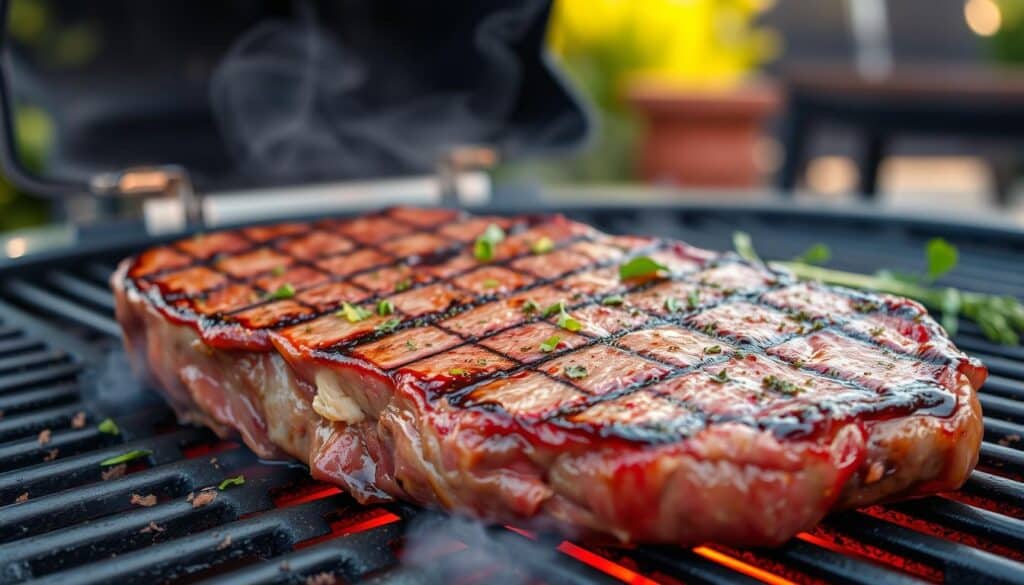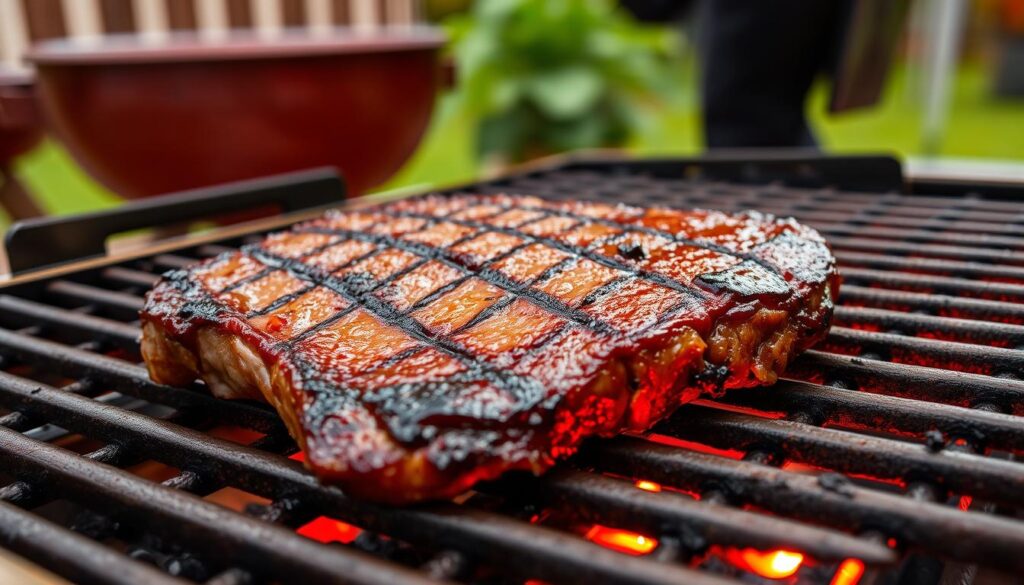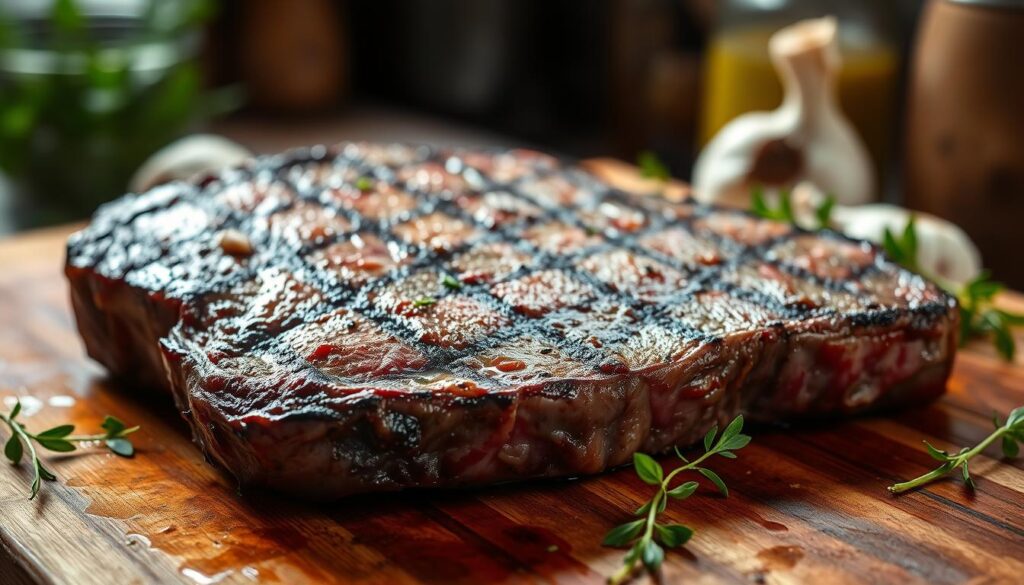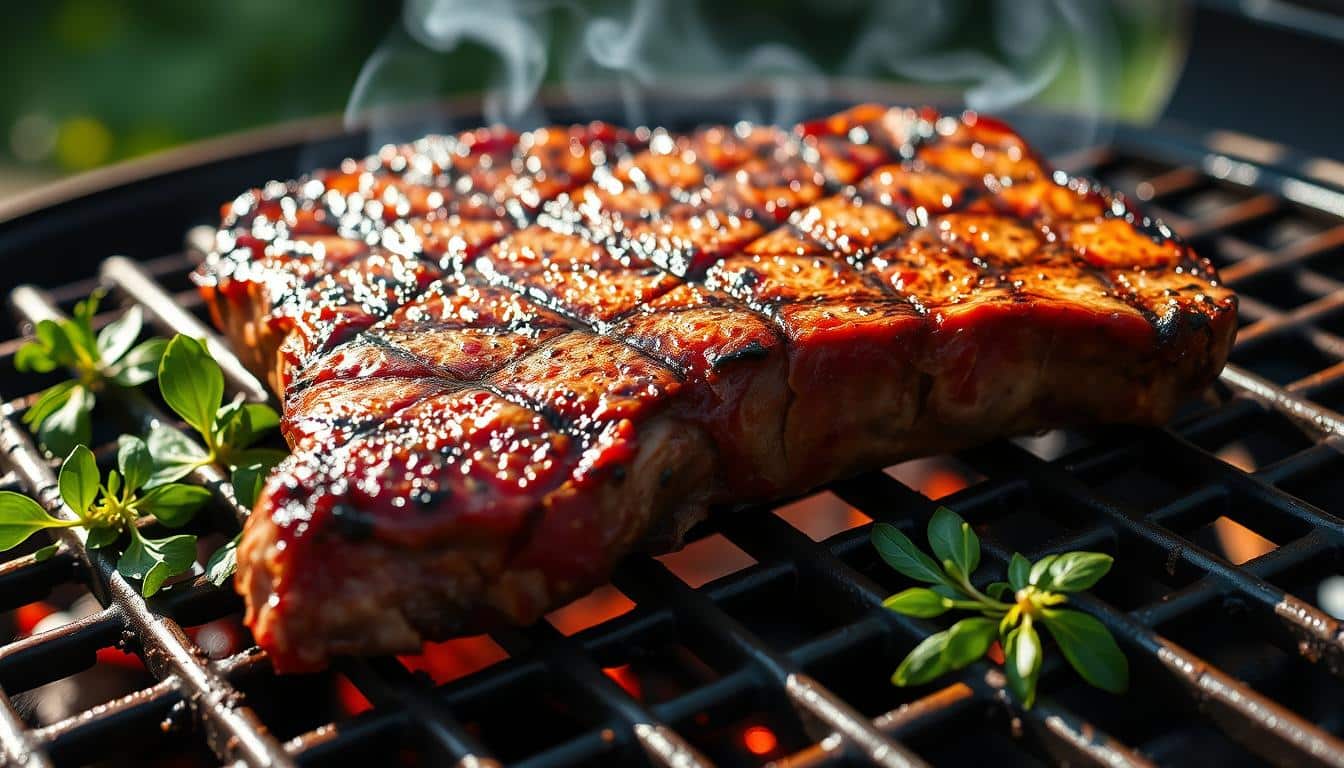Grilling a perfect ribeye steak is like a dance of skill and patience. We’re here to show you how to make a delicious Grilled Ribeye at home. We’ll teach you how to pick the best cut and use the right barbecue techniques.
This guide covers everything you need to know about grilling a ribeye. We’ll talk about choosing the right cut, preparing it, and cooking it just right. Whether you’re experienced or new to grilling, our tips will make your steak amazing and impress your friends.
Understanding the Perfect Ribeye Cut
Choosing the right ribeye cut is key for a great grilling experience. We’ll look at what makes a ribeye special, like its marbling and aging.
Marbling and Its Impact on Flavor
Marbling means white fat streaks in the meat. A well-marbled ribeye roast tastes better and stays juicier. The fat melts while cooking, making the steak tender and tasty.
Prime vs Choice vs Select Grades
The USDA grades ribeye based on marbling and age. Prime has the most marbling, followed by Choice and Select. Here’s a quick guide:
| Grade | Marbling | Flavor | Tenderness |
|---|---|---|---|
| Prime | Abundant | Rich | Very tender |
| Choice | Moderate | Good | Tender |
| Select | Slight | Mild | Less tender |
Dry-Aged vs Wet-Aged Beef
Aging changes the taste and feel of ribeye steaks. Dry-aged beef loses moisture, making flavors stronger. It becomes tender and flavorful. Wet-aged beef is sealed and aged in its juices, with a milder taste.
“Dry-aged beef is like a fine wine – it gets better with time, developing complex flavors and unparalleled tenderness.”
Knowing these details will help you pick the best ribeye for your next grilling.
Essential Equipment for Grilling Ribeye
Grilling the perfect ribeye needs more than skill. You also need the right tools and equipment. Let’s look at what you’ll need for your next barbecue.
Choosing the Right Grill Type
The key to great grilling is your grill. Gas grills are easy to use and control the heat well. Charcoal grills give that smoky flavor many love. A combo grill is the best of both worlds.

Temperature Control Tools
Getting the temperature right is key for a perfect ribeye. A good meat thermometer is a must. It makes sure your steak is cooked just right. A grill surface thermometer keeps the heat even.
Must-Have Grilling Accessories
Here are the tools you need for easy grilling:
- Long-handled tongs for safe handling
- Sturdy spatula for flipping
- Grill brush for cleaning
- Heat-resistant gloves for protection
- Cast iron skillet for searing
| Accessory | Purpose | Importance |
|---|---|---|
| Meat Thermometer | Measure internal temperature | Critical |
| Grill Brush | Clean grates | High |
| Tongs | Handle meat safely | Essential |
| Spatula | Flip steaks | Important |
| Heat-Resistant Gloves | Protect hands | Safety |
With these tools, you’re ready to grill a delicious ribeye. Good equipment helps you get better at grilling. This means your food will always taste great.
Preparing Your Grilled Ribeye
Grilling the perfect beef steak starts with proper preparation. We’ll guide you through the essential steps. This will help you get your prime rib eye ready for the grill. The goal is to bring out the best flavors and ensure even cooking.
First, take your ribeye out of the fridge about 30 minutes before grilling. This lets the steak warm up to room temperature. This helps it cook evenly. While waiting, trim any excess fat from the edges. Leave a thin layer for flavor.
Next, pat the steak dry with paper towels. This step is key for a beautiful crust. Moisture on the surface can ruin the searing process. So, make sure your steak is as dry as possible.
“A well-prepared steak is halfway to perfection on the grill.”
If you’re looking for something different, skirt steak offers a flavorful alternative. It has its own unique preparation methods.
Once your ribeye is at room temperature and dry, it’s ready for seasoning. A quality prime rib eye doesn’t need much. A simple rub of salt and pepper can enhance its natural flavors.
- Remove steak from refrigerator 30 minutes before grilling
- Trim excess fat, leaving a thin layer
- Pat the steak dry thoroughly
- Season as desired
With these steps done, your ribeye is ready for grilling perfection. Now, you can show off your grilling skills. Create a mouthwatering beef steak that will impress any dinner guest.
The Art of Seasoning Ribeye
Seasoning is key to bringing out the best in a Grilled Ribeye. We’ll look at ways to make your beef steak taste amazing.
Salt Timing and Technique
Salting your ribeye is an art. Salt it 40 minutes before grilling for the best taste. Use coarse sea salt for even flavor.
Dry Rub Combinations
Dry rubs can make your Grilled Ribeye even better. Try this mix:
- 2 tablespoons black pepper
- 2 tablespoons paprika
- 1 tablespoon garlic powder
- 1 tablespoon onion powder
- 1 teaspoon cayenne pepper
Coat your steak with this mix before grilling.
Marinade Options and Tips
Marinades can add more flavor to your ribeye. A simple red wine marinade is great:
| Ingredient | Amount |
|---|---|
| Red wine | 1 cup |
| Olive oil | 1/4 cup |
| Minced garlic | 2 cloves |
| Fresh rosemary | 1 sprig |
Marinate your ribeye for 2-4 hours in the fridge. Don’t marinate for more than 8 hours to avoid mushy meat.
Temperature and Timing Guide
Grilling the perfect ribeye needs careful attention to temperature and timing. We’ve created a detailed guide to help you get the perfect doneness every time you grill.
For rare steaks, aim for an internal temperature of 125°F (52°C). If you like your steak medium-rare, target 135°F (57°C). For medium, cook to 145°F (63°C). And for medium-well, aim for 150°F (66°C).
| Doneness | Internal Temperature | Grilling Time (per side) |
|---|---|---|
| Rare | 125°F (52°C) | 3-4 minutes |
| Medium-Rare | 135°F (57°C) | 4-5 minutes |
| Medium | 145°F (63°C) | 5-6 minutes |
| Medium-Well | 150°F (66°C) | 6-7 minutes |
Let your steak rest for 5-10 minutes after grilling. This makes it moist and flavorful. Use a meat thermometer to check the temperature accurately.
By following this guide, you’ll become a pro at grilling ribeye. Try different temperatures and timings to find your perfect steak.
Mastering the Perfect Grilled Ribeye
Grilling a ribeye steak is an art. It needs technique, timing, and temperature control. We’ll look at ways to get that perfect Grilled Ribeye you dream of.
Direct Heat Method
The direct heat method is a classic for grilling ribeye. Heat your grill to 450-500°F. Place the steak over the heat and grill for 4-5 minutes per side for medium-rare. This method makes a tasty crust and keeps the inside juicy.

Reverse Sear Technique
The reverse sear is great for thick-cut ribeyes. Cook the steak on low heat until it’s 115°F. Then, sear it over high heat for a minute or two per side. This method cooks evenly and adds a perfect crust.
Managing Flare-ups
Flare-ups can char your ribeye and ruin its taste. To handle them, set up a two-zone fire on your grill. If flare-ups happen, move the steak to the cooler side until they go away. Trim excess fat from the steak before grilling to lessen flare-ups.
| Grilling Method | Cooking Time | Internal Temperature |
|---|---|---|
| Direct Heat | 8-10 minutes total | 135°F for medium-rare |
| Reverse Sear | 45-60 minutes total | 135°F for medium-rare |
With these methods, you’ll grill perfect ribeye steaks every time. Always let your steak rest for 5-10 minutes before slicing. This keeps its juices in.
Advanced Grilling Techniques
Want to improve your barbecue skills? We have expert tips for grilling the perfect cowboy steak. These advanced methods will make your backyard cookout feel like a fancy restaurant.
Two-Zone Fire Setup
A two-zone fire is key for grilling thick cuts like ribeye. Here’s how to do it:
- Pile charcoal on one side of your grill
- Leave the other side empty
- This creates a hot zone for searing and a cooler zone for slow cooking
This setup lets you control your steak’s doneness. Sear it on the hot side, then move it to the cool side to finish cooking without burning.
Smoke Infusion Methods
Want to add depth to your grilled ribeye? Try these smoke infusion techniques:
| Method | Wood Type | Flavor Profile |
|---|---|---|
| Wood Chips | Hickory | Strong, bacon-like |
| Wood Chunks | Oak | Medium, smoky |
| Pellets | Apple | Mild, sweet |
Soak your chosen wood for 30 minutes before adding it to the hot coals. This slow release of smoke will infuse your steak with rich, complex flavors. Remember, a little smoke goes a long way – don’t overpower the natural taste of your cowboy steak.
Resting and Serving Your Steak
After grilling your ribeye to perfection, the final steps are key. We’ll show you how to rest, slice, and present your steak. This will impress your guests and bring out the flavors.
Proper Resting Times
Resting your grilled ribeye is key for juicy results. Let it sit for 5-10 minutes, depending on its thickness. This lets juices spread evenly, making each bite tender and full of flavor.

Slicing Techniques
For the best texture, slice your steak against the grain. Use a sharp knife and cut at a slight angle. This breaks down muscle fibers, making the steak more tender. Aim for slices about 1/4 to 1/2 inch thick.
Presentation Tips
Make your grilled ribeye presentation stand out with these tips:
- Arrange slices on a warm plate to keep them hot
- Garnish with fresh herbs like rosemary or thyme
- Drizzle with a pat of compound butter for extra flavor
- Serve with grilled vegetables or a crisp salad for balance
Mastering these final steps will take your grilled ribeye from good to great. Your perfectly cooked steak will be the highlight of any meal. It will impress everyone with its professional look and delicious taste.
Common Grilling Mistakes to Avoid
We’ve all been there – excited to fire up the grill for a perfect ribeye, only to end up with a disappointing result. Let’s explore some common pitfalls in grilling and barbecue, and how to sidestep them for a mouthwatering steak every time.
One frequent error is overcooking. Many grillers leave their steaks on the heat too long, resulting in a dry, tough piece of meat. Instead, use a meat thermometer to achieve your desired doneness. For medium-rare, aim for an internal temperature of 135°F (57°C).
Another mistake is improper seasoning. Some folks go overboard with complex rubs, masking the natural flavors of the ribeye. Keep it simple – a generous coating of salt and pepper is often all you need to enhance the steak’s taste.
“The best steak is the one that lets the beef shine through. Don’t overshadow it with too many seasonings.”
Lastly, neglecting to let the steak rest after grilling is a big error. Cutting into your ribeye immediately after it comes off the grill causes all those flavorful juices to spill out. Give it 5-10 minutes to rest, allowing the juices to redistribute throughout the meat for a juicier, more tender bite.
- Don’t flip the steak too often; once or twice is enough
- Avoid pressing down on the steak with your spatula
- Ensure your grill is clean and preheated before cooking
By steering clear of these common grilling mistakes, you’ll be well on your way to mastering the art of the perfect ribeye. Remember, practice makes perfect, so don’t be discouraged if your first attempts aren’t flawless. Happy grilling!
Conclusion
We’ve looked into grilling the perfect ribeye steak. Choosing a good cut and controlling the temperature are key. Remember, patience is important for a delicious grilled ribeye.
Using quality ingredients is vital. Pick a well-marbled ribeye for the best taste and texture. Seasoning adds flavor without overpowering the beef. You can use a simple rub or a complex marinade, letting the meat’s taste stand out.
Try techniques like the reverse sear or a two-zone fire setup to improve your ribeye. Always let your steak rest before slicing. This makes it tender and juicy. With these tips, you can make a great grilled ribeye in your backyard.

